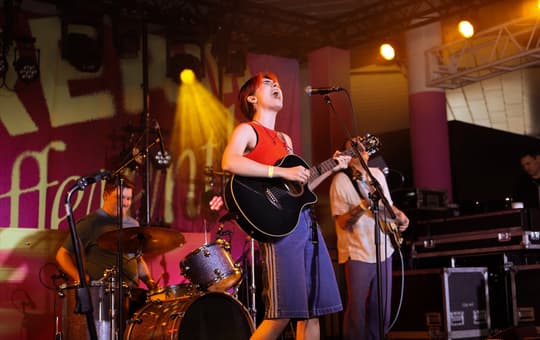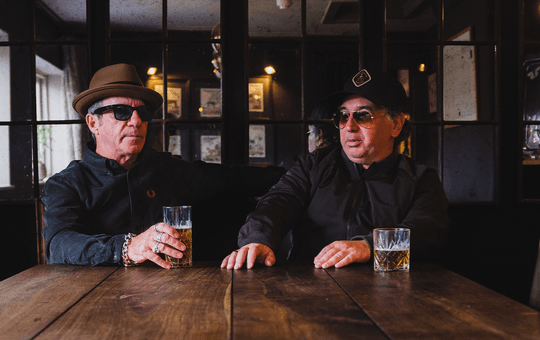The Dummy Guide To Cold Wave
This March, Angular Recordings will release the cold-wave compilation COLD–WAVES AND MINIMAL ELECTRONICS VOL.1. The idea of Cold-Wave as a genre remains a difficult beast to try and capture, file or contain. The music often collected under that banner is strongly associated with the evolution of late 70’s French and Belgian punk bands, but it also grew to take in electronic experimenters from Canada to Austraila as well as UK Industrial acts and American minimalists. As its primarily signifier is and was the use of newly affordable electronic instruments there’s an argument to be made that the ‘genre’ should embrace Eastern European bands cut off by Cold War politics from any pretence of a francophone ‘scene’.
And so, from our lofty 21st Century perspective, Cold-Wave appears to mount repeated incursions into an almost unknowable number of previously well guarded genres: EBM, Synthpop, Techno, Italo, the brutally minimal punk of Joy Division, the electronic Futurism of Kraftwerk. United mainly by barely commodified electronics and tiny print runs of 7“s and later cassettes (although somewhat morbidly respectable by today’s sales standards).
All of this decentralised music making makes an easily digestible guide all but impossible. So, instead, here’s a 14-point guide to getting immersed in Cold-Wave. Hopefully it’ll enable you to plot your own story of a bunch of people committing to tape their apocalyptic fears, their futurist dreams, their gloriously naive love songs. Well, it’s a start…
1 In the beginning there were three chords and a synthesizer
There are two fundemental components to Cold-Wave. The social/economic/political which informed the group’s aesthetic from the nebulous feeling of mood through to lyrical content and the technological. For it was the newly (just about) affordable synths from manufacturers such as Korg and Arp that allowed the actual electronic sounds that burst forth from these records to actually exist. Sythn legend Wendy Carlos (she of Clockwork Orange OST fame) released the wildly popular ‘Switch On Bach’ in 1968 but it wasn’t until a decade later that Korg released the MS-20 (which in a quirk of correlation was in production between 1978-1983 – almost the entire heyday of Cold-Wave). These comodified, semi-portable (for performing live) machines didn’t do anything revolutionary in terms of sound. Bigger, better machines did it all much earlier but crucially these new, small, relatively inexpensive instruments were suddenly in the hands of punks.
2 After the thaw, stagnation then the cold-wave
In addition to the minimal electronic sound that marked the music we now classify as Cold-Wave, the other main signifier of the genre was its tone: the icy, emotionless, apocalyptic and often irreverent atmosphere conjured up against a backdrop of global recession, Iranian political crisis and nuclear threat. The name Cold-Wave remains so enduring precisely because it synthesized the political meteorological metaphors of the time with a convenient description of the atmosphere of the music. Not to mention the wave suffix. That never gets old.
3 Kraftwerk
It would be hard to underestimate the influence that Kraftwerk has on bands making electronic music for mass consumption in the late 70s early 80s. Acting as the godfathers of electronic pop (as well as Hip-Hop, Techno et al) they paved the way at Kling Klang, acting as a beacon for the cold-wave / minimal synth bands to follow with their newly affordable technology. The loop would go full circle as Kraftwerk embraced the commodified synths of their acolytes (the Omni Mk2 for instance) and produced Computer World, marrying their conceptual futurism with the naïve pop of the Synth-Wave bands.
4 Industrial music – Throbbing Gristle, tape swaps and decentralised music distribution
Emerging from the art world with their first incarnation, COUM, Throbbing Gristle would go on to be credited with inventing Industrial Music (a genre that’s seeing a land grab by Cold-Wave revisionists). Significant for the Cold-Wave acts was their use of hand made electronic instruments, self-released records and pioneering use of tape networks to distribute their work. While some Cold-Wave bands, especially in France had access to major label backing, many later bands were nurtured by the DIY ethos successfully employed by Throbbing Gristle and their Industrial Records. Chris Carter (who built their infamous Gristliser effects boxes) would go on to form Chris and Cosey with fellow band member Cosey Fanny Tutti. Their 1984 album ‘Songs of Love and Lust’ eerily deconstructs the tropes of the disintegrating synth wave bands as the dominance of synth-pop on the UK charts sucks the life out of the movement.
5 Key bands to start out with
5.1 Jacno (France)
Jacno’s first solo sngle was the Minimal Synth classic Rectangle in 1979. He started off in one of the earliest French punk bands, Stinky Toys before embracing synthesizers and inspiring a generation of Cold-Wave bands. Rectangle remains interesting as a transitional track, not entirely eschewing guitars or embracing the icier atmosphere that the Cold-Wave acolytes would embrace. However, its success in the charts and the visibility of this former punk embracing the minimal electronic sound provided a catalyst and a commercial argument for the French Cold-Wave that was already forming. Sadly, Jacno (Denis Quilliard) died in November 2009 at the age of 52.
5.2 Ruth (France)
As well as punk, Cold-Wave drew on experimental and Musique Concrète movements within classical music as, decades before, they’d embraced electronic composition. The man behind Ruth, Thierry Müller, came from this direction with his earlier releases as Illitch. Ruth was his attempt to break from the earnestness of that project and enter the pop/punk world. Hooking up with Phillipe Doray in 1980 they recorded the J.G. Ballard influenced Pile ou Face but it wasn’t until 1982 that they first demoed their masterpiece ‘Polaroid / Roman / Photo’ (whose masterful coverart illustrates this story). Mournful synths, the repetitive sound of camera film being wound on, and a deadpan/coquettish duet make this one of the greatest minimal synth tracks ever recorded. By all accounts the subsequent album on the Paris Album label only sold 50 copies. Whether you believe that is another matter.
5.3 Charles de Goal (France)
Of the bands that are grouped together under Cold-Wave, Charles de Goal sound closest to the ‘angular’ guitars of UK Post-Punk. Which is not to say they eschew the synthesizers, drum machines or the urgent vocal delivery of their peers, simply that they incorporate live drumming, guitars and more of the other remnants of Punk. They also differed in actually being rather long lived putting out records into the late 80’s before their return in the last few years. Their first album ‘Algorythems’ mixes up these competing houses of punk and Cold-Wave, with the track Radio On encapsulating this best.
5.4 Iko (Canada)
Very little is known about the Canadian Synth-Wave group Iko. They released one album called ’83 and a 7” that contained the stand-out album tracks Digital Delight and Approach to Tokyo. Their music seems less indebted to the post-punks of the Cold-Wave and, if it were possible, even more forward-looking, anticipating a kind of nihilistic form of Hi-NRG or a sped up Detroit Techno. Digital Delight sits perfectly between those two camps. Pitched down it recalls the gloriously minimalist early Techno of Cybertron’s Clear that would be released the next year, although the integration of Funk and Soul to Synth-Wave would be Detroit Techno’s genius rather than a straight continuation of the European sound. But that’s another article altogether.
Please note: this is pitched up too high but any other (correct) version that gets uploaded to YouTube quickly get pulled down.
5.5 Oppenheimer Analysis (UK)
The UK’s relationship to Synth-Wave and Cold-Wave was endlessly complicated by the twin pillars of Post-Punk and Synth-Pop that sandwiched the short time it could be said to have existed. Thankfully, the DIY ethos of those years had been laid down; with early Indie labels able to put out these bands while the rest of the UK industry studiously ignored them (at least initially). One of these groups was the Oppeheimer Analysis formed by Andy Oppenheimer and Martin Lloyd. Playing in pubs and Sci-Fi conventions they put out one cassette in 1982 and nothing else until 2005 when the NYC label Minimal Waves put out their first 12” containing some of the tracks from the cassette as well as unreleased work. Hear their rolling, boyishly apocalyptic pied piper anthem The Devil’s Dancers here:
6 The UK synth-wave / synth-pop transformation
While many of the continental Cold-Wave bands faded into domesticity and obscurity their UK equivalents had a knack of parlaying minimalist experimentation into pop success. Depeche Mode were arguably the most successful at this, carving out a career that’s now spanned (amazingly) four decades.
The Human League went from Kraftwerk influenced all male Synth group to the chart bothering male/female combo who put out Dare. Interestingly the group acted as the incubator to Cold-Wave band Clock DVA (formed by Adi Newton who was in The Human League’s first incarnation, The Future), Sythn-Wave band BEF and Synth-Pop band Heaven 17, both formed by Martyn Ware and Ian Craig Marsh after ‘creative differences’ with original The Human League member Phil Oakley. Listen to the menacing, addictive early version of Being Boiled here.
Simple Minds straddled several movements from punk through to stadium rock but for a short period in the early 80s they produced several albums that seemed acutely aware of the minimal synth music being made around them. Empires and Dance in 1980 through to 1981’s Sister Feelings Call (which contains the glorious Theme for Great Cities ) present the strongest case for their Synth-Wave credentials before stadium tours and US success took hold.
7 Where it is now
7.1 Minimal Wave Records
Minimal Wave Records was started by Veronica Vasicka in 2005. It grew out of an online project to collate information about Minimal Synth and New Wave bands as well as from DJing duties on East Village Radio. The vinyl only label specializes in releasing long out of print records which are often packaged with demos and unreleased songs the bands are eager to put out. The label’s website has a wealth of detail on their releases as well as interviews with the bands (Andy Oppenheimer is a particularly good read) and a very active forum.
7.2 Born Bad Records
Born Bad Records have been dutifully cataloguing the Francophone side of Cold-Wave since their excellent compilation BIPPP which is thankfully still in print. They then collaborated with a Paris exhibition on Post Punk and Cold-Wave to release the compilation ‘Des Jeunes Gens Modernes’ which encapsulated the equivocal divide of punk and Cold-Wave as well as including (on the CD) a series of cover versions by ‘modern’ bands.
7.3 Wierd Club / Wierd Records
Pieter Schoolwerth began throwing his Wierd parties in 2003. Acting as an outlet for Pieter’s Cold-Wave collection they began attracting large enough crowds to evolve into full fledged club nights hosting bands that would go on to appear on the Wierd Records label (formed in 2006). While instrumental in highlighting the desire for Cold-Wave music in his native NYC it’s the new music being put out by Wierd Records that will probably do most to resurrect the genre. Fantastic albums by Xeno & Oaklander and Led Er Est lead the way. Pieter, along with Angular Records’ Joe Daniel, is responsible for the compilation ‘Cold-Waves and Minimal Electronics Vol.1 that, along with Minimal Waves’ ‘The Minimal Wave Tapes Vol. 1’ should provide those drawn by the new Cold-Wave / Synth-Wave / Minimal-Wave bands an easy entry into the history of the genre(s).
7.4 New Wave of Cold-Wave
The last few years has seen a procession of bands seemingly embrace the minimalist synth aesthetic and oppressive atmosphere of the Cold-Wave acts (knowingly or otherwise). I’ve written endlessly about Petit Mal over on 20JazzFunkGreats and many people have written much more about recent Matador signees Cold Cave. Xeno & Oaklander (see Wierd Records above) have been putting out outstanding Minimal-Synth records for the last few years along with label mates Led Er Est and Blackout. Heir to Charles de Goal, Plug, will have an album out on Upset The Rhythm later this year and their fantastic single You Keep The Beats manages to integrate a snaky synth line with bass guitar and ‘live’ drums.
Selected sources
This oh so brief introduction to an enormously fertile but relatively obscure collection of music made over 30 years ago could not ever hope to be complete, or definitive or even, in some cases, penetrate the myths around phenomenally rare records whose creators are no doubt blissfully unaware of the cult around them. But, hopefully, it’s a start. A translation of the biographies to the artists on the BIPPP compilation was kindly supplied by JB at Born Bad Records. The Minimal Wave site is also a wonderful source of information.
Preorder Angular’s Cold Waves and Minimal Electronics Vol 1, or buy it in shops from the 8th of March.
Joe from Angular Records’ Cold Waves blog
As Dan mentioned, he also writes for 20 Jazz Funk Greats, the unfeasibly excellent blog.













